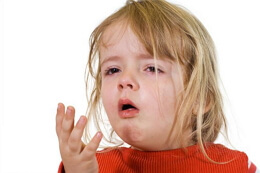Urticaria: symptoms, causes, treatment
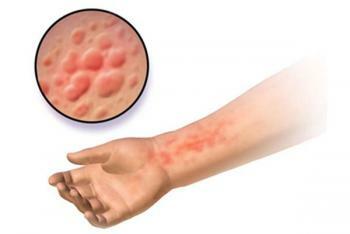
Urticaria, or urticaria, is a dermatitis that develops due to the hyperreactivity of the human immune system.A characteristic feature of urticaria is the appearance of primary elements in the form of pink blisters, raised above the surface of the skin.The reaction is accompanied by severe itching.
Pathology can develop independently on contact with an allergen or accompany another disease.It occurs often enough.According to medical statistics, almost every third person at least once in his life suffered hives.
Table of Contents: Classification Causes of urticaria development Symptoms of urticaria Diagnosis of cutaneous urticaria Treatment of urticaria PreventionClassification
Note: is also known as "nettle rash" and "nettle rash".Its name was received because of the similarity of symptoms with clinical manifestations of nettle burns.
By the nature of the current, it is customary to distinguish the following forms:
- acute urticaria;
- chronic urticaria.
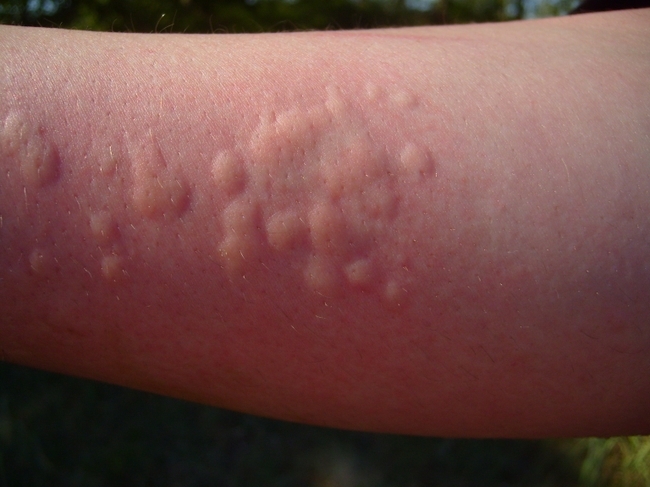 In acute course, the duration of the disease ranges from several days to two to six weeks.For a chronic form, a recurrent course is characteristic for many months and even years.Skin elements in the period of exacerbation may appear almost daily, and the duration of the remission phase may vary.
In acute course, the duration of the disease ranges from several days to two to six weeks.For a chronic form, a recurrent course is characteristic for many months and even years.Skin elements in the period of exacerbation may appear almost daily, and the duration of the remission phase may vary.
Acute form, in most cases, is fixed in childhood and adolescence, and in adults( 20-40 years) urticaria often has a chronic course.
Clinical and pathogenetic variants:
- Physical forms:
- cold urticaria;
- vibration( slow motion);
- urticaria due to pressure.
Separately consider such physical form of urticaria as "artificial urticaria".It is characterized by the appearance on the skin of puffiness and blister, after it was carried by a solid object.This variety often accompanies chronic hives.
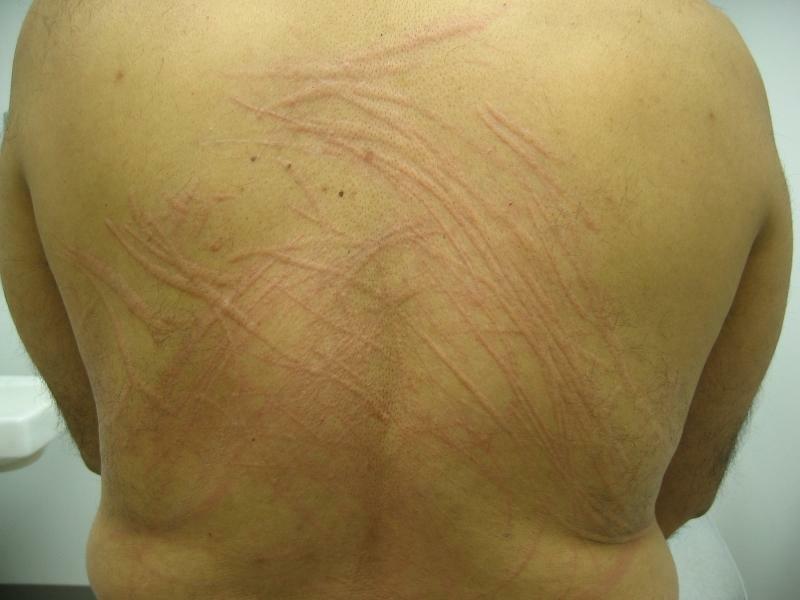
- Special shapes:
- contact;
- is adrenergic;
- cholinergic;
- Solar;
- aquatic.
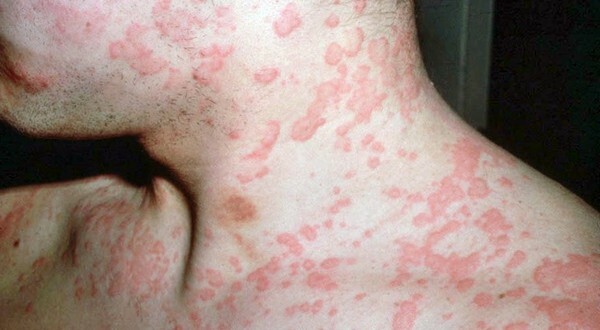 Note: in the medical literature, you can find references to a special form of dermatosis - atypical "papular" urticaria.The belonging of this pathology to allergic dermatitis is questioned.There is nothing in common with this urticaria and mastocytosis, although this disease is sometimes called "pigmentary urticaria."
Note: in the medical literature, you can find references to a special form of dermatosis - atypical "papular" urticaria.The belonging of this pathology to allergic dermatitis is questioned.There is nothing in common with this urticaria and mastocytosis, although this disease is sometimes called "pigmentary urticaria."
If the allergen is not detected and systemic diseases that could provoke a characteristic rash are not found, the patient is diagnosed with idiopathic urticaria.In chronic form, the obvious causes of allergy remain unsettled in more than half of the cases.
Causes of urticaria development
The most common allergic dermatitis develops after the administration of medications.These include serums, vaccines, radiopaque substances, NSAIDs( acetylsalicylic acid), gamma globulins and antibiotics.An allergic reaction can also develop as a result of a viral infection and in response to contact with bacterial toxins, insect secretions or some food products( nuts, eggs, seafood, etc.).

Note: The frequency of urticaria is higher in female patients belonging to the age group of 20 to 60 years.Researchers attribute this to the features of the female neuroendocrine system.At the heart of the pathogenesis of urticaria in most cases is the damaging effect of a certain substance on which the immune system reacts by the activation( degranulation) of mast cells, which is accompanied by an active release of the mediator( histamine), which is synthesized and deposited in them.The reaction is accompanied by an increase in the permeability of the vascular walls, as a result of which the liquid part of the blood exits into surrounding tissues and edema develops.

Important: according to modern classification, acute urticaria is considered as an allergic disease due to IgE antibodies, and the chronic form is considered to be non-allergic before the detection of the immunological mechanism of development.
An autoimmune theory of the development of chronic urticaria in adults has now been developed.A relationship of comparatively high morbidity among patients suffering from autoimmune thyroiditis( thyroid dysfunction) has been established.Urticaria often accompanies infectious diseases of bacterial, viral and fungal etiology, helminthiases, autoimmune pathologies, serum sickness and oncological diseases.
Symptoms of hives
Symptoms of urticaria in children and adults are similar.
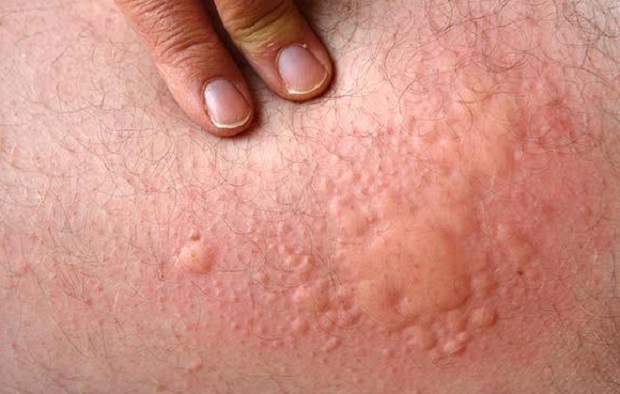 The surface of the skin develops limited puffiness, resulting in the formation of primary elements in the form of blisters.They are pink and pale when pressed.There are blisters swiftly, and the resolution occurs within a day without the formation of secondary elements.
The surface of the skin develops limited puffiness, resulting in the formation of primary elements in the form of blisters.They are pink and pale when pressed.There are blisters swiftly, and the resolution occurs within a day without the formation of secondary elements.
Note: is an important difference between urticaria and Quincke edema is that in the first case, edema affects the papillary layer of the dermis, and in the second - deep layers of the skin and subcutaneous fat.
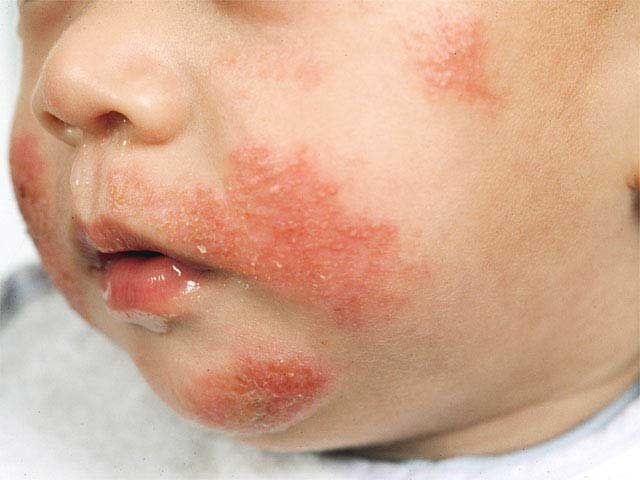 The localization of blisters can be very diverse, but the most intense elements appear on the head and neck, since the skin of these areas contains the greatest number of histamine-containing mast cells( mast cells).
The localization of blisters can be very diverse, but the most intense elements appear on the head and neck, since the skin of these areas contains the greatest number of histamine-containing mast cells( mast cells).
For physical forms of pathology, the resolution of primary elements is characteristic within 2 hours.The exception is delayed urticaria due to pressure.
Appearance of rashes on the skin is accompanied by severe itching.
With urticaria, general clinical manifestations such as enlarged liver and spleen( hepatosplenomegaly), febrile reaction, swelling in the projection of the joints and lymphadenopathy( enlargement of the lymph nodes) can develop.
Diagnosis of cutaneous urticaria
Diagnosis of acute urticaria and the identification of a specific factor that caused a hypersensitivity reaction( allergen) in most cases is not difficult.Detection of the chronic form requires careful collection of anamnesis and additional studies, including laboratory tests and, if necessary, ultrasound and fluoroscopy of nasal sinuses and chest organs.
Treatment of urticaria
How to treat hives can only be established by a doctor;Take any measures yourself is not recommended
Treatment of urticaria in adults and children requires complete elimination of contact with the allergen.Non-drug therapy, in addition to eliminating etiological factors, implies adherence to a diet with a minimum content of histamine-liberators.
 Pathogenetic therapy involves taking antihistamines that inhibit the release of the main mediator of allergy.H1-histaminoblockers of the first generation include Atarax and Dimedrol, and to the second generation( selective blockers of peripheral histamine receptors) - Clarinex, Claritin and Zirtek.More effective are antihistamine preparations of the third generation.
Pathogenetic therapy involves taking antihistamines that inhibit the release of the main mediator of allergy.H1-histaminoblockers of the first generation include Atarax and Dimedrol, and to the second generation( selective blockers of peripheral histamine receptors) - Clarinex, Claritin and Zirtek.More effective are antihistamine preparations of the third generation.
Severe course of the disease may require the use of systemic hormonal drugs from the group of corticosteroids.They can not be used for a long time, in order to avoid the development of serious side effects such as osteoporosis, weight gain, and a significant decrease in the functional activity of the adrenal glands.The duration of the course of corticosteroids is a maximum of 5-7 days.
In addition, or as basic drugs, leukotriene receptor blockers( Acolat, Singular) are often prescribed.They are most effective in cases when urticaria is caused by a reaction to non-steroidal anti-inflammatory drugs.
In difficult cases, when treatment is ineffective, anti-inflammatory drugs( salfacilate Sulfalazine) and preparations from the group of immunosuppressors( in particular - Ciclosporin) are shown.
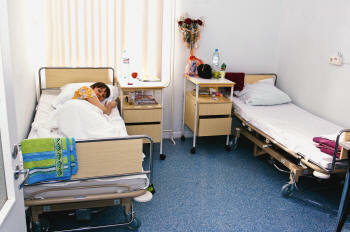 In especially severe cases of autoimmune form of chronic urticaria, therapy is performed in specialized medical institutions.Patients are shown immunosuppressors, intravenous immunoglobulin and plasmapheresis.
In especially severe cases of autoimmune form of chronic urticaria, therapy is performed in specialized medical institutions.Patients are shown immunosuppressors, intravenous immunoglobulin and plasmapheresis.
For the relief of skin itching, it is advisable to use such external topical products as soothing lotions and cold lotions.
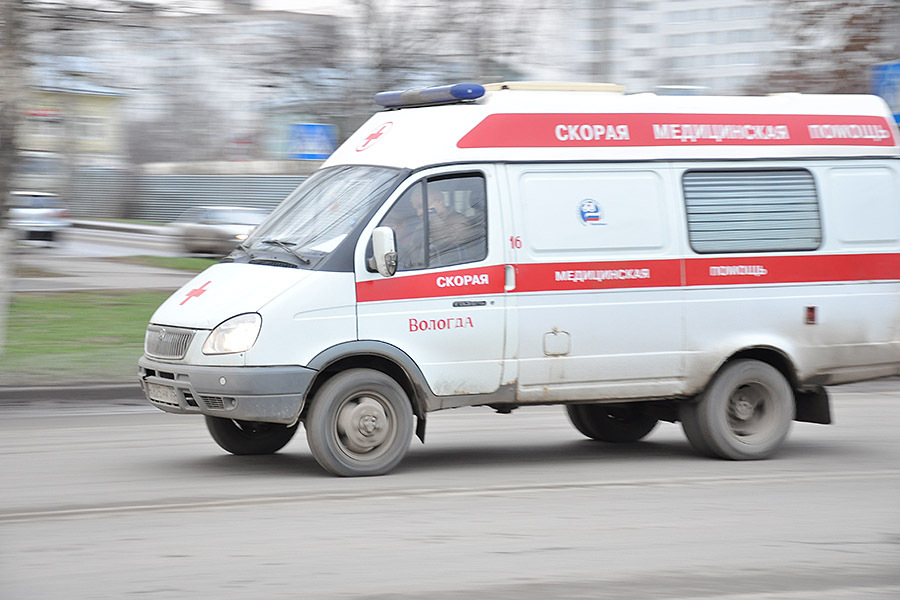 If swelling captures large areas of skin and spreads to the mucous membranes, this can be considered a life threatening condition.In such cases, especially when combined with urticaria and angioedema( angioedema), emergency measures must be taken.The patient needs adrenaline( epinephrine) and high doses of steroid drugs( prednisolone).In addition, oxygen inhalation is indicated.
If swelling captures large areas of skin and spreads to the mucous membranes, this can be considered a life threatening condition.In such cases, especially when combined with urticaria and angioedema( angioedema), emergency measures must be taken.The patient needs adrenaline( epinephrine) and high doses of steroid drugs( prednisolone).In addition, oxygen inhalation is indicated.
Prevention
In any form of urticaria, the use of alcoholic beverages is categorically contraindicated, since alcohol is a nonspecific trigger factor.
Patients are advised to avoid physical exertion, stress, hypothermia and overheating.To exclude pressure on the skin, it is recommended that you do not wear tight clothing, suspenders and straps.
In the chronic form in the acute phase it is advisable to adhere to a special hypoallergenic diet.

More detailed information about the signs, the causes of urticaria and the methods of treatment of its various forms you will get by viewing this video review:
Plisov Vladimir, medical reviewer, phyto-therapeutist
